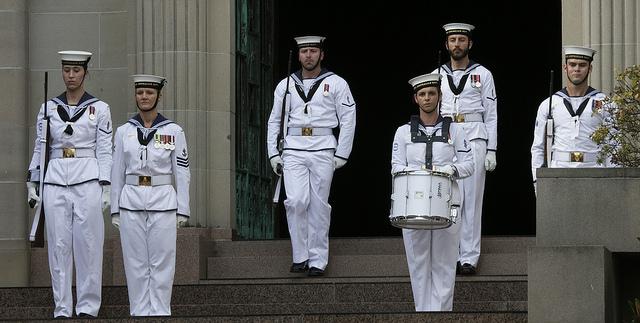75th anniversary of the Battle of Sunda Strait and the loss of the HMAS Perth

Last Post Ceremony to commemorate the 75th Anniversary of the Battle of Sunda Strait and the loss of the HMAS Perth, Australian War Memorial 2017. See all official photographs.
Today we pause commemorate the 75th anniversary of one of the most significant events not only in the history of the Royal Australian Navy, but of our nation.
On this day 75 years ago in 1942 the Australian light cruiser HMAS Perth was sunk in the battle of the Sunda Strait with the loss of more than 350 members of her crew.
On the 28th of February, HMAS Perth and the heavy cruiser USS Houston were making for the southern coast of Java after the fall of Singapore only two weeks earlier.
Perth and Houston were the only large Allied ships to have survived the Battle of the Java Sea the day before.
They had retreated to Tanjong Priok, where they arrived on 28 February.
The two ships attempted to resupply, but fuel shortages meant that Perth took on only half her normal fuel capacity, and a lack of shells left the cruisers with what little ammunition was left over from the previous day.
Perth, Houston, and the Dutch destroyer Evertsen had been ordered to sail for Tjilatjap via the Sunda Strait.
Late that evening of the 28th, they encountered the Japanese ‘western invasion convoy’ at the northern entrance to the Sunda Strait.
The convoy was escorted by a large Japanese flotilla of two light cruisers, eight destroyers and a minelayer, supported by another four cruisers, an aircraft carrier and further destroyers.
Heavily outnumbered, soon running low on ammunition and changing course constantly to avoid attacks from every direction, the Australian and American crews fought desperately against impossible odds.
Together Perth and Houston sank a Japanese transport and a minesweeper, then severely damaged a further three transports.
But under the immense weight of Japanese numbers and superior firepower, the end was inevitable.
Japanese ships launched 85 torpedoes during the brief engagement.
Perth suffered her first hit from a Japanese shell at 11.26 p.m.
At midnight, with ammunition running low, displaying immense courage and strength of character, Perth’s Captain, ‘Hec’ Waller, ordered his ship to try to force a way through.
Soon after midnight the first torpedo struck.
With her crew reduced to firing practice shells and illumination starshells, a second torpedo hit Perth shortly afterwards, Captain Waller ordered “Abandon ship”.
Perth was hit by two more torpedoes before finally sinking at 25 minutes after midnight on the 1st of March.
The action was all over in just under an hour from the time the first round struck.
Although ablaze from enemy fire, USS Houston continued to fight on. She was rent by shell and torpedo explosions and sank just 20 minutes later.
The captains of both vessels went down with their ships.
Of the 686 men on board HMAS Perth, more than half—over 350 officers and ratings—perished in this, her last action.
Of the 320 survivors captured by the Japanese, one-third died during their long ordeal as prisoners of war.
Of the more than 1,000 American officers and men aboard USS Houston, less than 400 escaped their sinking ship. Only 266 of them survived the harsh regime of brutality and starvation in Japanese prisoner of war camps.
Together, we remember the brave seamen of both vessels, as well as those of the other Allied warships—Australian, British, American and Dutch sailors—who were lost in the series of engagements in the Java Sea while attempting to repel large Japanese invasion forces.